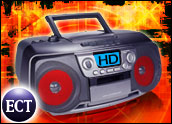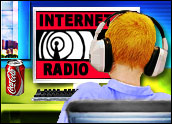
It used to be called digital radio before the marketers decided to exploit the high definition craze in broadcasting and recast it as HD Radio, but whatever it’s called, it could be just the weapon airwave floggers need to fend off a growing threat for their audience from satellite radio.
Satellite radio has gained more than nine million paying subscribers in four years and is starting to put a crunch on the traditional broadcasting market, according to a study released on Monday by ABI Research, of Oyster Bay, N.Y.
“Satellite radio is the fastest growing consumer electronics technology in history,” Frank Viquez, director of ABI’s transportation practice and author of the report, told the E-Commerce Times. “Broadcasters are going to have to do something, or they’re going to lose a lot of the audience to satellite radio.”
Dissatisfied With Programming
That “something” appears to be HD Radio. It will raise the bar for what broadcasters have to offer, making AM radio the quality of FM radio and FM near-CD quality.
However, aural issues aren’t the only ones driving listeners to satellite radio. “The fact that you have all these people subscribing to this service just shows that they’re tired of the programming they’re getting on AM and FM,” Viquez asserted.
“Programming has a huge amount to do with this,” he continues. A broadcast station plays about 20 minutes of music an hour, he estimated. “The other 40 minutes is commercials and talk,” he said. “People are tired of it. Consumers are sending a message that they’re not willing to put up with this any more.”
Viquez acknowledged that broadcasters would be going digital without satellite radio competition because, among other things, it allows them to increase their broadcast channels at a relatively small cost and without government intervention. However, sat-rad, he noted, “has had a huge part influencing how quickly this is being deployed.”
No Need to Panic
Although broadcasters are stepping up the pace of their digital conversion, another study released last month by Arbitron and Edison Media Research suggests that there’s no need for them to panic about satellite radio.
According to that study, a copy of which was obtained by the E-Commerce Times, 77 percent of digital radio listeners — which includes Internet radio, podcasts and sat-rad — said that they expect to listen to as much broadcast radio as they do now despite advances in technology.
“This research does not support the belief that AM/FM radio is losing a significant portion of its audience to these new digital radio choices,” the report said.
It noted that the average consumer spends two hours, 45 minutes, listening to broadcast radio, compared to two hours, 48 minutes, for listeners of digital radio.
Interestingly, the researchers discovered that some 43 percent of satellite radio subscribers said they were very or somewhat interested in HD radio. That compares to 35 percent of all respondents who said they were either very or somewhat interested in the technology.
Perspective Needed
The amount of publicity garnered by satellite radio may be distorting its place in the market, according to Clark Smidt, a principal in Broadcast Ideas, a consulting firm in Andover, Mass.
“Ten million annual subscribers is no match to radio’s 270 million weekly listeners,” he told the E-Commerce Times. “That encompasses, roughly, 94 percent of everybody age 12 or over in the United States.
“A subscriber means they’re capable of receiving it, but it doesn’t mean they’re listening to it all the time,” Smidt added.
He conceded, though, that satellite radio has lit a fire under broadcasters to move on HD radio. “Satellite radio provided the impetus for broadcasters to explore HD radio,” he said. “Without it, development of HD radio would have been slower.
“Satellite is just no match for the number of receivers, the quality of radio stations and the ability to serve a local audience that radio has always provided and continues to provide,” Smidt declared.























































Social Media
See all Social Media